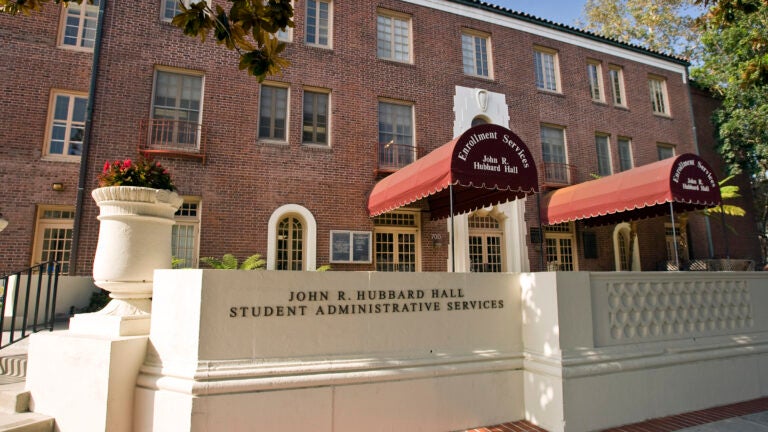
Hubbard Hall on the University Park Campus is home to USC Financial Aid. (Photo/Phillip Channing)
USC among the first universities to join a cost transparency initiative to help students decide
The first wave of more than 360 U.S. universities and colleges has met a new gold standard of transparency in financial aid packages and cost estimates for potential students.
The College Cost Transparency Initiative on Tuesday announced USC is among the first 360 universities and colleges around the country that have fulfilled its new standards for cost transparency and aid disclosure.
“This is an acknowledgment of the efforts put into providing an award summary that provides clarity to students and families regarding their financial aid offer,” Kedra Ishop, USC vice president for enrollment management, said about the significance of USC’s new College Cost Transparency Initiative (CCT) membership. “It means that the USC Financial Aid Summary and Tasks (FAST) award that we have provided to students since 2015 is transparent, that we are doing exactly what these standards ask us to do.”
Altogether, the new coalition members serve more than 3.5 million students. USC itself has more than 49,000 students — an estimated 21,000 of whom are undergraduates.
“This is an acknowledgment of the efforts put into providing an award summary that provides clarity to students and families regarding their financial aid offer.”
— Kedra Ishop, USC vice president for enrollment management
To join the special initiative, universities and colleges have had to undergo a review of their financial aid award summaries so that the CCT could determine whether their financial aid and cost information is clear and accurate. Ishop said USC has long strived to make it easy for students and their families to consider the university’s offer.
The new CCT membership “is a seal of approval for us,” Ishop said.
By launching the initiative, CCT is essentially establishing a set of principles for disclosure across higher education — at least for those who want such certification. The organization’s standards require that financial aid award letters and documents clearly outline the costs involved with attendance and the full details of student financial aid packages, including accurate estimates for grants, loans and scholarships, as well as other important financial details.
Ideally, with CCT’s standards in place at multiple universities, students should be able to accurately and fairly compare their offers to determine which institution is right for them, Ishop said.
New standards supported by higher education
The CCT Initiative was launched last fall when leaders of 10 higher education associations representing college presidents, financial aid offices, and admissions and school counselors formed a task force to tackle the issue of college cost transparency. The task force aimed to improve the clarity, accuracy and understanding of student financial aid offers.
With input from the higher education community, the task force set guiding principles and minimum standards for colleges and universities to consider when developing aid offers.
Organizations that advised the task force included the Association of American Universities, of which USC is a member. USC President Carol L. Folt is the chair of the AAU’s Board of Directors.
The task force also was advised by the American Council on Education, the American Association of Community Colleges, the American Association of State Colleges and Universities, the Association of Public and Land-Grant Universities, the National Association for College Admission Counseling, the National Association of Independent Colleges and Universities, the National Association of Student Financial Aid Administrators, the National Association of System Heads and the State Higher Education Executive Officers Association.
“Students and families need upfront, accurate and clear information when making decisions about college.”
— Peter McPherson, College Cost Transparency Initiative
“Students and families need upfront, accurate and clear information when making decisions about college,” Peter McPherson, chair of the CCT task force and president emeritus of the Association of Public and Land-Grant Universities said in an announcement posted online by CCT.
“Some standard terminology and clear requirements on what is to be included in financial aid offers is important,” he said. ”Colleges and universities are committing to give students and families the information they need.”
The CCT Initiative will be managed by the National Association of Student Financial Aid Administrators, which is sponsored by a grant from Strada Education Foundation.
The CCT Initiative principles and standards on transparency for financial aid and costs requires that offers:
- Are transparent, ensuring that costs are understandable for students and families, and include the most accurate estimate possible of a student’s costs.
- Describe and explain all types of aid offered using standardized, plain language.
- Prominently display critical components, such as an estimate of the student’s total cost of attendance, broken down by costs to be paid to the institution and costs paid to others; types and sources of financial aid being offered, separated into grants and scholarships, student loans and student employment or work; an estimated net price; and more.
- Follow U.S. Department of Education guidance on how best to reference the Parent PLUS Loans.
- Provide information about employment requirements and information on job placement, if student employment is offered.
- Explain the terms and conditions and information on how much student loan debt may cost over time if federal student loans are included.
The CCT on Tuesday also released a set of financial aid offer examples that meet the initiative’s principles and standards for institutions to use in developing or updating their aid offers and a glossary of common financial aid terms and definitions.



